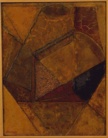
Greek artists were painting with encaustic as long ago as the 5th century BCE. The Roman historian Pliny, who wrote in the 1st century CE, tells us it was being used for the painting of portraits and scenes of mythology on panels, for the coloring of marble and terra cotta, including on architecture, and for work on ivory (probably the tinting of incised lines).
Perhaps the best known of all encaustic work are the Fayum funeral portraits painted in the 1st through 3rd centuries CE by Greek painters in Egypt. A portrait of the deceased, painted either in the prime of life or after death, was placed over the person's mummy as a memorial. These are the only surviving encaustic works from ancient times.
Over the intervening centuries, encaustic was overtaken by many other types of paint — including tempera, oil, and acrylic paints — each of which was cheaper, faster, and easier to work. Artists experimented with encaustic in the 18th and 19th centuries, but it wasn't until the 20th century that its use has really revived. Only with the availability of portable electric heating devices for the melting of the wax has the use of encaustic become sufficiently accessible. Encaustic has become so versatile indeed that many contemporary painters consider it an attractive painting medium again. Modern painters who have used encaustic include Robert Delaunay, Antoine Pevsner, Diego Rivera, and Jasper Johns.
Once applied to a surface, encaustic paint doesn't need to dry. Instead, it needs to cool. Because it cools in minutes, additional coats can be added almost immediately. Once its surface has cooled, encaustic paint presents a permanent finish, and yet the painting can be revised and reworked at any time — whether seconds later or years later. It is a particularly durable paint, because wax is waterproof and over time can retain all the freshness of a newly finished work.
Encaustic can be laid on in delicately thin glazes or super thick encrusted impastos. It can produce satisfying results whether applied with painstaking precision or with flamboyant spontaneity. It can be carved, shaped and molded — built to high or low relief.
Its adhesiveness makes it an excellent collage medium that can be impregnated with a wide variety of other materials.
The surface quality of encaustic paint can be left roughly textured, or given a matte, semi-gloss, or glossy enamel-like finish.
![]() Encaustic painting does not require solvents other than heat.
Encaustic painting does not require solvents other than heat. ![]()
![]()
As
a consequence, health hazards associated with other solvents are reduced or eliminated. Nevertheless, users should take precautions because wax is flammable, and when hot can burn the skin.
The term "encaustic" can also refer to a painting made in this medium.
Examples:

Greece, South Italian (Apulian), attributed
to the Group of Boston, Column-krater, c. 360-350 BCE,
red-figure terra
cotta, height 20 1/4
inches (51.51 cm), Metropolitan Museum of Art, NY. This vase
provides a rare depiction of the actual painting process, in
which the encaustic pigments
were mixed with wax, and
applied to sculptures in ancient Greece.

Egypt, second century CE
(Roman Period), Portrait of a Boy, encaustic on wood,
height 15 3/8 x 7 1/2 inches
(39 x 19 cm), Metropolitan Museum of Art, NY. See Egyptian art and Fayum
portraits.
Egypt, second century CE (Hawara, Roman Period), Funerary Portrait of a Young Girl, encaustic on wood, height 15 3/4 inches, Cleveland Museum of Art.
![]()
Roman, Fayum, Egypt, 100-125 CE,
Attributed to the Isidora Master, Mummy Portrait of a Woman, Isidora, encaustic
and gilt on a wooden
panel wrapped in linen, 13 1/4
x 6 3/4 inches (33.6 x 17.2 cm), J. Paul Getty Museum, Malibu,
CA.
Egypt, Antinoöpolis, Portrait of a Woman with Earrings, c. 130-150 CE, encaustic on wood, 22.5 x 35.3 cm, Sackler Art Museum, Harvard U, MA.

Egyptian (Hawara, Roman Period, second century
CE),
Funerary Portrait of a Young Girl, encaustic
on wood, height 15 3/4 inches,
Cleveland Museum of Art.

Antoine Pevsner (French, born Russia, 1886-1962, to Paris 1923), Abstract Forms, 1913? (1923?), encaustic on wood, 17 1/4 x 13 1/2 inches (43.8 x 34.3 cm), Museum of Modern Art, NY.
Jasper Johns (American, 1930-), Three Flags, 1958, encaustic on canvas, 30 7/8 x 45 1/2 x 5 inches (78.4 x 115.6 x 12.7 cm), Whitney Museum of American Art, NY. See flag and Pop Art.

Jasper Johns, Figure 5, 1960, encaustic and newspaper
collaged on canvas, 183 x 137.5 cm, Georges Pompidou Center,
Paris.
Also see Fayum portraits, melting point, and temperature.
https://inform.quest/_art
Copyright © 1996-![]()